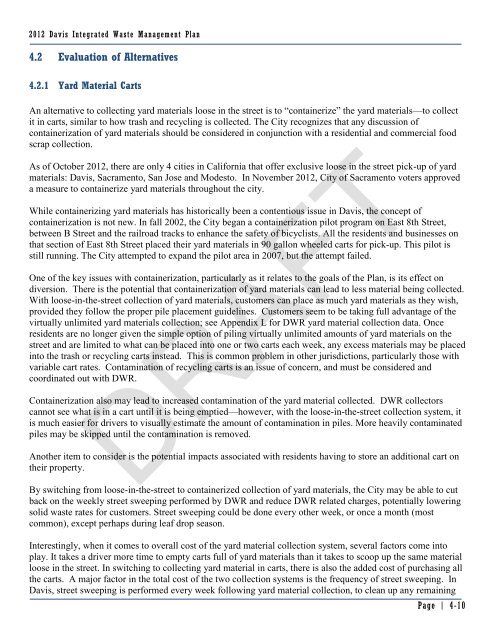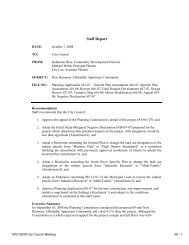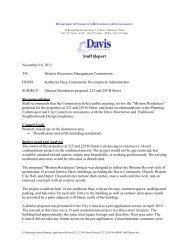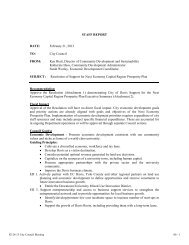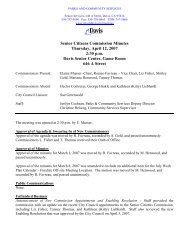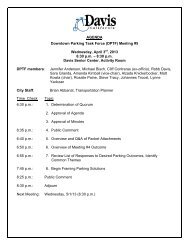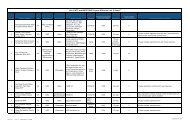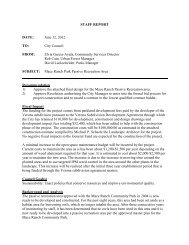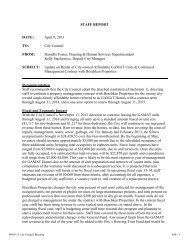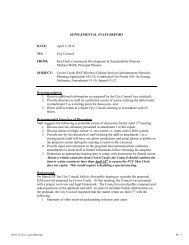10 Draft Integrated Waste Management Plan - City Council - City of ...
10 Draft Integrated Waste Management Plan - City Council - City of ...
10 Draft Integrated Waste Management Plan - City Council - City of ...
You also want an ePaper? Increase the reach of your titles
YUMPU automatically turns print PDFs into web optimized ePapers that Google loves.
2012 Davis <strong>Integrated</strong> <strong>Waste</strong> <strong>Management</strong> <strong>Plan</strong><br />
4.2<br />
Evaluation <strong>of</strong> Alternatives<br />
4.2.1 Yard Material Carts<br />
An alternative to collecting yard materials loose in the street is to “containerize” the yard materials—to collect<br />
it in carts, similar to how trash and recycling is collected. The <strong>City</strong> recognizes that any discussion <strong>of</strong><br />
containerization <strong>of</strong> yard materials should be considered in conjunction with a residential and commercial food<br />
scrap collection.<br />
As <strong>of</strong> October 2012, there are only 4 cities in California that <strong>of</strong>fer exclusive loose in the street pick-up <strong>of</strong> yard<br />
materials: Davis, Sacramento, San Jose and Modesto. In November 2012, <strong>City</strong> <strong>of</strong> Sacramento voters approved<br />
a measure to containerize yard materials throughout the city.<br />
While containerizing yard materials has historically been a contentious issue in Davis, the concept <strong>of</strong><br />
containerization is not new. In fall 2002, the <strong>City</strong> began a containerization pilot program on East 8th Street,<br />
between B Street and the railroad tracks to enhance the safety <strong>of</strong> bicyclists. All the residents and businesses on<br />
that section <strong>of</strong> East 8th Street placed their yard materials in 90 gallon wheeled carts for pick-up. This pilot is<br />
still running. The <strong>City</strong> attempted to expand the pilot area in 2007, but the attempt failed.<br />
One <strong>of</strong> the key issues with containerization, particularly as it relates to the goals <strong>of</strong> the <strong>Plan</strong>, is its effect on<br />
diversion. There is the potential that containerization <strong>of</strong> yard materials can lead to less material being collected.<br />
With loose-in-the-street collection <strong>of</strong> yard materials, customers can place as much yard materials as they wish,<br />
provided they follow the proper pile placement guidelines. Customers seem to be taking full advantage <strong>of</strong> the<br />
virtually unlimited yard materials collection; see Appendix L for DWR yard material collection data. Once<br />
residents are no longer given the simple option <strong>of</strong> piling virtually unlimited amounts <strong>of</strong> yard materials on the<br />
street and are limited to what can be placed into one or two carts each week, any excess materials may be placed<br />
into the trash or recycling carts instead. This is common problem in other jurisdictions, particularly those with<br />
variable cart rates. Contamination <strong>of</strong> recycling carts is an issue <strong>of</strong> concern, and must be considered and<br />
coordinated out with DWR.<br />
Containerization also may lead to increased contamination <strong>of</strong> the yard material collected. DWR collectors<br />
cannot see what is in a cart until it is being emptied—however, with the loose-in-the-street collection system, it<br />
is much easier for drivers to visually estimate the amount <strong>of</strong> contamination in piles. More heavily contaminated<br />
piles may be skipped until the contamination is removed.<br />
DRAFT<br />
Another item to consider is the potential impacts associated with residents having to store an additional cart on<br />
their property.<br />
By switching from loose-in-the-street to containerized collection <strong>of</strong> yard materials, the <strong>City</strong> may be able to cut<br />
back on the weekly street sweeping performed by DWR and reduce DWR related charges, potentially lowering<br />
solid waste rates for customers. Street sweeping could be done every other week, or once a month (most<br />
common), except perhaps during leaf drop season.<br />
Interestingly, when it comes to overall cost <strong>of</strong> the yard material collection system, several factors come into<br />
play. It takes a driver more time to empty carts full <strong>of</strong> yard materials than it takes to scoop up the same material<br />
loose in the street. In switching to collecting yard material in carts, there is also the added cost <strong>of</strong> purchasing all<br />
the carts. A major factor in the total cost <strong>of</strong> the two collection systems is the frequency <strong>of</strong> street sweeping. In<br />
Davis, street sweeping is performed every week following yard material collection, to clean up any remaining<br />
Page | 4-<strong>10</strong>


